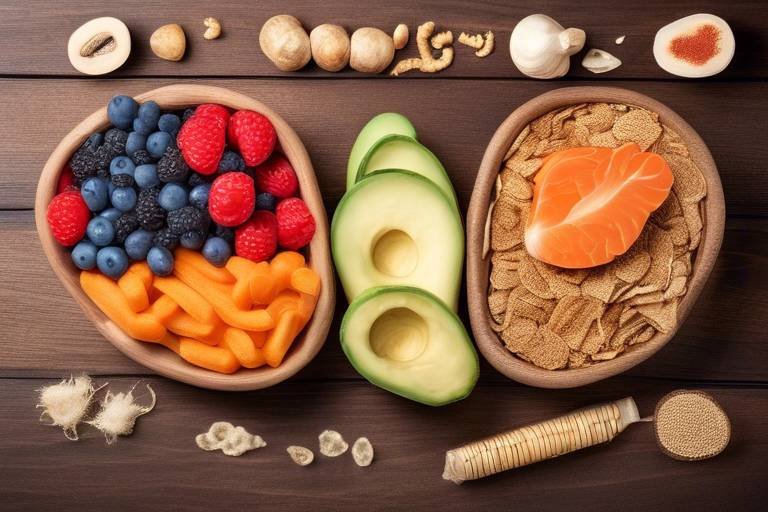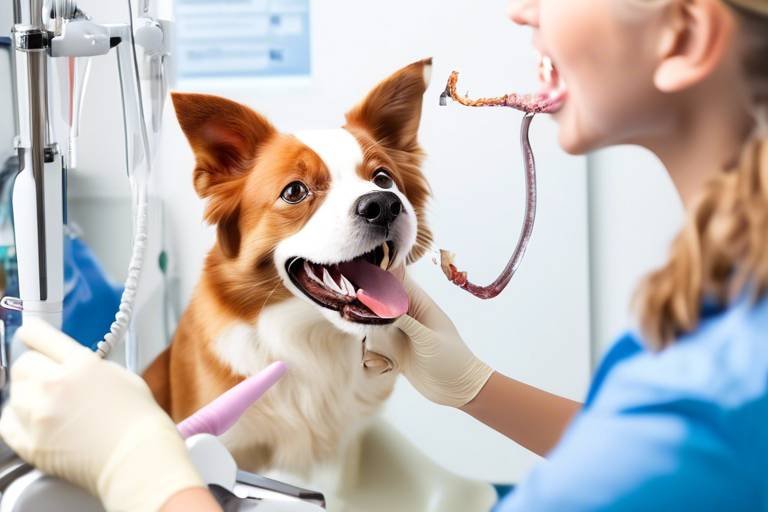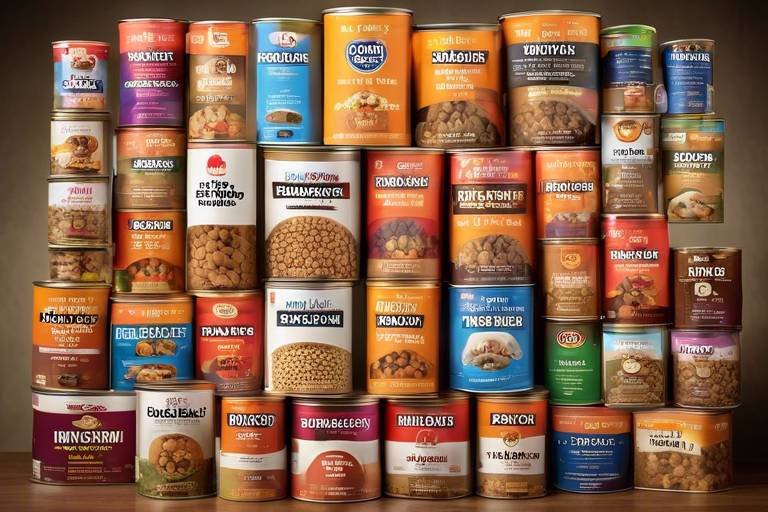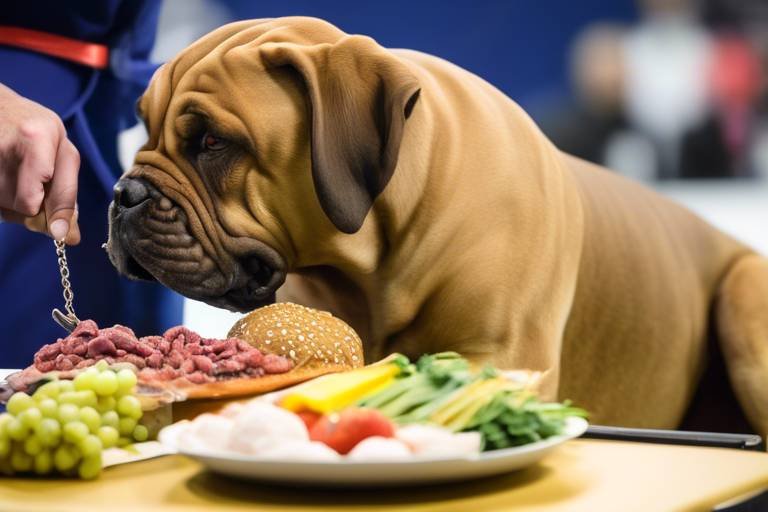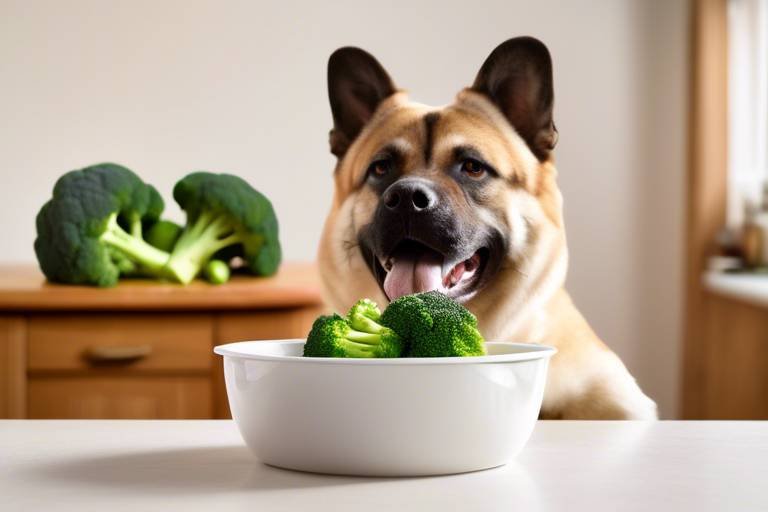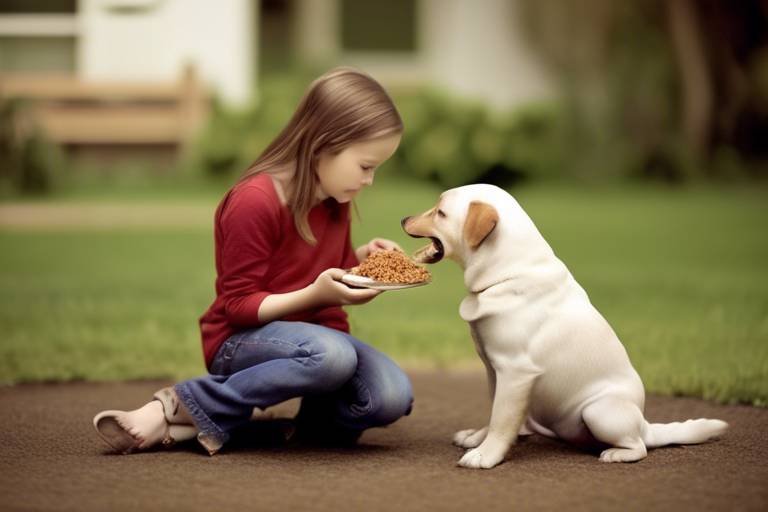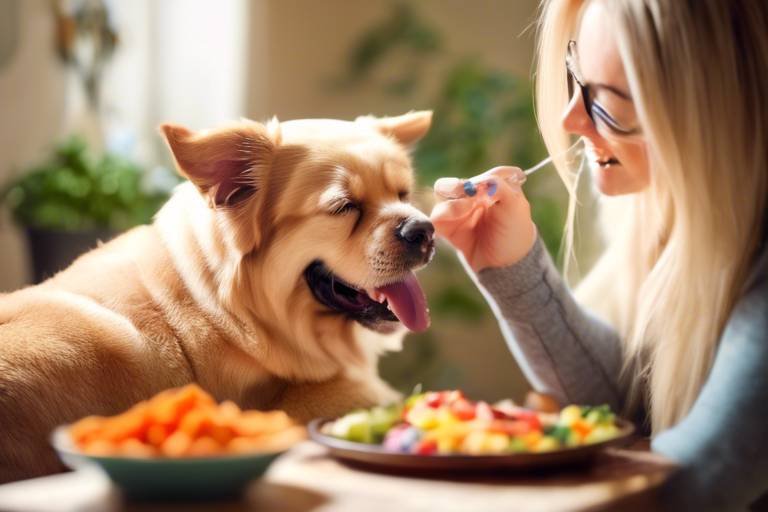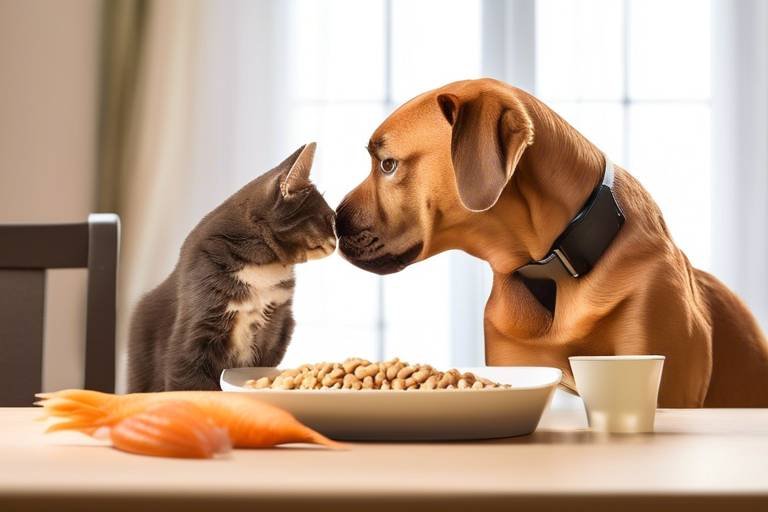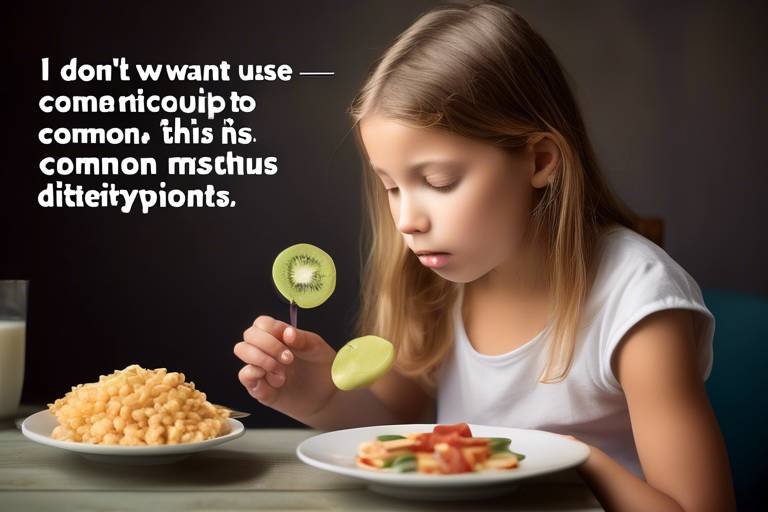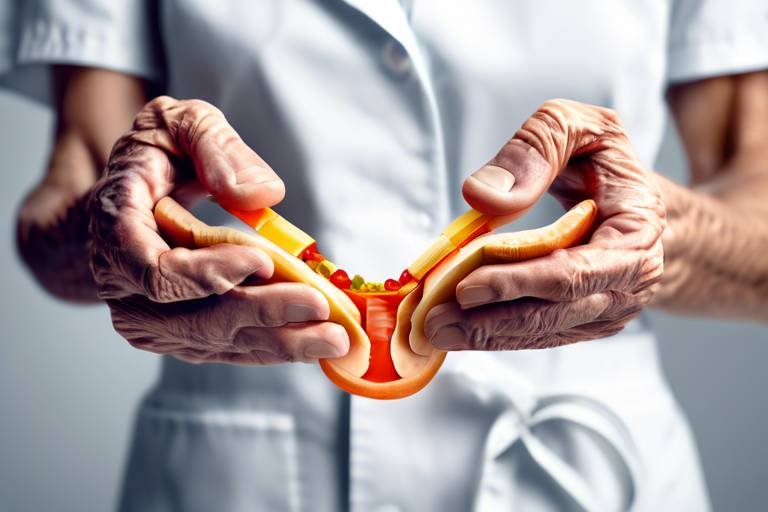How to Create Healthy Treats for Your Pet
Creating healthy treats for your pet is not just a fun activity; it's a way to show your furry friend how much you care about their well-being. Just like us, pets love snacks, but it’s essential to ensure that these treats are not only tasty but also packed with the right nutrients. With a little creativity and the right ingredients, you can whip up delicious snacks that will have your pet wagging their tail or purring with delight. Imagine the joy on their face when they realize you’ve made something special just for them! In this article, we’ll dive into various methods and recipes for making nutritious and delectable treats for your pets, ensuring they stay happy and healthy while indulging in their snacks.
Every pet has unique dietary requirements that vary based on their age, breed, size, and health conditions. Understanding these needs is crucial for creating treats that provide essential nutrients without compromising their health. For instance, puppies may require more protein for growth, while older dogs might benefit from treats that support joint health. Cats, on the other hand, are obligate carnivores, meaning they thrive on a diet rich in meat. It's essential to consult with your veterinarian to tailor treats that fit your pet’s specific nutritional needs, ensuring they receive a balanced diet that complements their regular meals.
Selecting the right ingredients is vital for your pet's safety. While many human foods are safe and even beneficial for pets, others can be harmful or toxic. This section covers which human foods are safe and beneficial for pets, and which to avoid. For example, while peanut butter can be a great source of protein for dogs, chocolate is a definite no-go. Knowing what to include and what to skip can make all the difference in your pet's health.
Many everyday ingredients are safe for pets and can be used to create tasty treats. Incorporating a variety of fruits, vegetables, and grains can enhance the nutritional value of your pet's snacks. Here are some examples of safe ingredients:
- Fruits: Apples, bananas, blueberries, and watermelon (without seeds) are all great choices.
- Vegetables: Carrots, green beans, and sweet potatoes can add crunch and nutrients.
- Grains: Oats and brown rice are excellent sources of carbohydrates.
Certain fruits and vegetables are packed with vitamins and can be great additions to your pet's diet while providing tasty flavors. For example, carrots are not only low in calories but also high in fiber and beta-carotene, which is great for your pet’s vision. Similarly, blueberries are rich in antioxidants that help combat aging and improve heart health. By incorporating these ingredients into your homemade treats, you're not just treating your pet; you're also contributing to their overall health.
Grains and proteins can be healthy components of pet treats. Oats are a fantastic source of fiber and can help with digestion, while proteins like chicken, beef, or fish provide essential amino acids that are crucial for your pet's muscle development and energy levels. When creating your treats, consider using whole grains and high-quality protein sources to ensure your pet receives the best nutrition possible.
Not all human foods are safe for pets. Some common ingredients that should never be included in homemade treats are:
- Chocolate: Toxic to both dogs and cats.
- Onions and garlic: Can cause gastrointestinal upset and damage red blood cells.
- Grapes and raisins: Can lead to kidney failure in dogs.
Being aware of these harmful ingredients is crucial for keeping your pet safe and healthy.
Creating treats at home can be fun and rewarding. With just a few simple ingredients, you can prepare delicious snacks that your pets will love. Let’s explore some easy recipes that require minimal effort.
Dogs enjoy a variety of flavors, and here are a couple of simple recipes tailored specifically for canine companions:
1. Peanut Butter and Banana Biscuits - 1 ripe banana - 1/2 cup peanut butter (unsweetened) - 1 1/2 cups whole wheat flour - Mix all ingredients, roll into balls, and bake at 350°F for 15 minutes. 2. Sweet Potato Chews - 1 sweet potato - Slice thinly and bake at 250°F for 3 hours.
Cats have different taste preferences, and here are some recipes designed to appeal to feline friends while maintaining their health and nutrition:
1. Tuna Treats - 1 can of tuna in water - 1 egg - 1 cup whole wheat flour - Blend all ingredients, roll into balls, and bake at 350°F for 10-12 minutes. 2. Chicken Bites - 1 cup cooked chicken, shredded - 1/2 cup oat flour - Mix and form small balls, bake at 350°F for 15 minutes.
Proper storage and serving are essential for maintaining the freshness of homemade treats. Store your treats in an airtight container in a cool, dry place, and they can last for up to a week. For longer storage, consider freezing them in small batches. When serving, always monitor your pet’s reaction to new treats and start with small portions to avoid digestive issues.
After introducing new treats, it's important to monitor your pet's health. Look for signs of allergies or digestive upset, such as vomiting, diarrhea, or changes in behavior. If you notice any adverse reactions, consult your veterinarian. Adjusting their diet accordingly can help ensure your pet remains healthy and happy.
Q: Can I use regular flour for pet treats?
A: It's best to use whole wheat flour or oat flour for better nutrition, but regular flour can be used in moderation.
Q: How often can I give my pet homemade treats?
A: Treats should make up no more than 10% of your pet's daily caloric intake to maintain a balanced diet.
Q: Are there any preservatives in homemade treats?
A: No, homemade treats are free from preservatives, making them a healthier option for your pet.

Understanding Your Pet's Nutritional Needs
Every pet is unique, and just like humans, they have their own specific dietary requirements that are crucial for their overall health and happiness. Understanding your furry friend's nutritional needs is the first step in creating treats that not only taste great but also provide essential nutrients. It's important to remember that pets are not just little humans; their bodies process food differently, which means their diets should be tailored to their specific needs.
For instance, dogs are omnivores, which means they can thrive on a mix of proteins, grains, and vegetables, while cats are obligate carnivores, requiring a diet rich in animal proteins. This fundamental difference highlights the importance of knowing what your pet needs. A well-balanced diet for your pet should include a variety of nutrients such as:
- Proteins: Essential for growth, maintenance, and repair of tissues.
- Fats: Provide energy and support cell growth.
- Carbohydrates: Serve as a primary energy source.
- Vitamins and Minerals: Crucial for various bodily functions, including immune response and bone health.
When creating homemade treats, consider your pet's age, size, and activity level, as these factors influence their nutritional requirements. For example, puppies and kittens require more calories and nutrients to support their growth, while older pets may need fewer calories but higher fiber to aid digestion. It's like tuning a musical instrument; each pet's dietary needs must be finely adjusted to ensure they are in perfect harmony.
Moreover, it's essential to consult with your veterinarian to tailor a diet that meets your pet's specific needs. They can provide insights into any dietary restrictions or allergies your pet may have, ensuring that every treat you make is not only delicious but also safe. By understanding these nutritional needs, you can craft treats that keep your pets healthy and happy, making each snack time a joyful experience.
In summary, knowing your pet's nutritional needs is the foundation for creating healthy treats. By focusing on a balanced diet that incorporates the right mix of proteins, fats, carbohydrates, vitamins, and minerals, you can ensure your furry friend enjoys their snacks while staying fit and healthy.
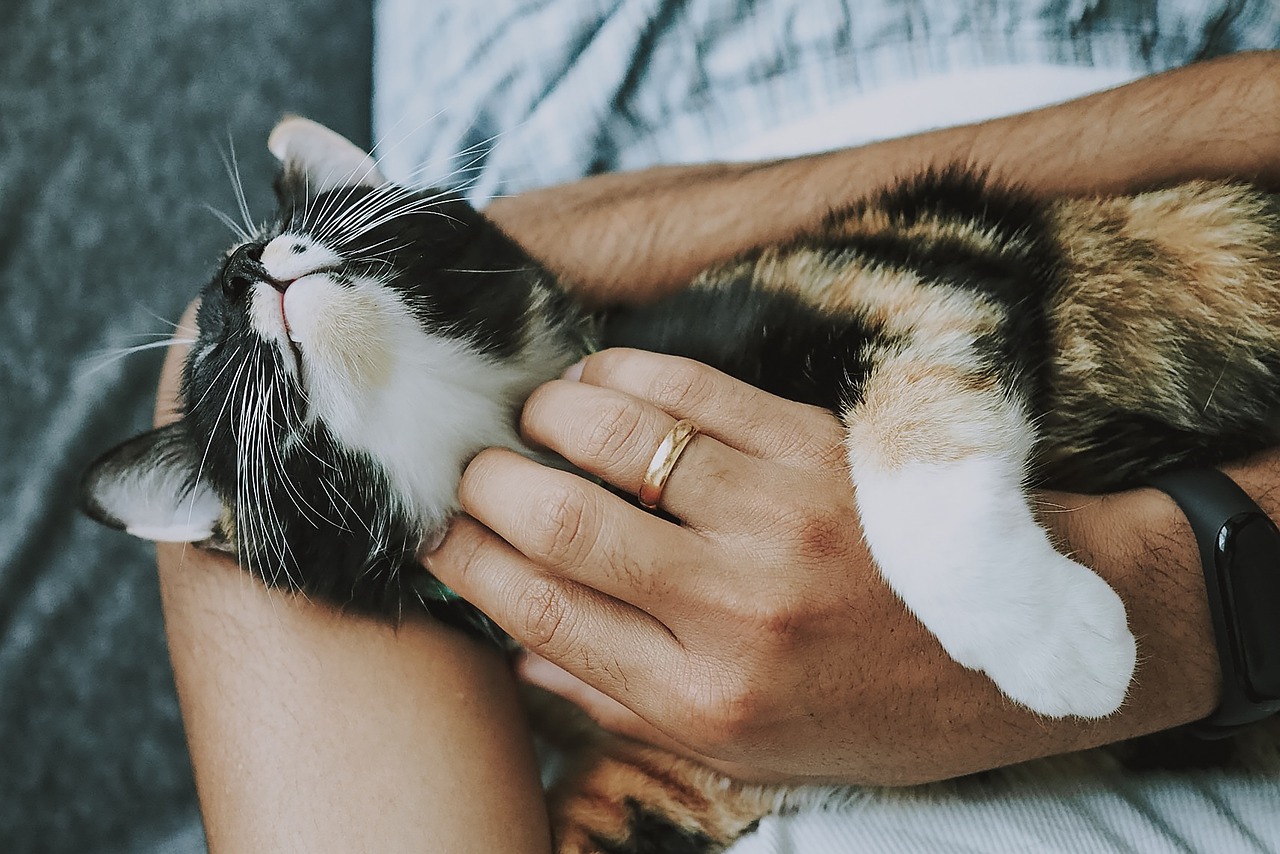
Choosing Safe Ingredients
When it comes to treating your beloved pet, the ingredients you choose are crucial. Just like us, pets have specific dietary needs, and selecting the right ingredients ensures they get the nutrition they deserve without any harmful side effects. It's not just about making tasty snacks; it's about keeping them healthy and happy. So, how do you know what’s safe? Let’s dive into the world of pet-friendly ingredients!
First off, it’s essential to remember that not all human food is suitable for our furry friends. While some foods can be beneficial, others can lead to serious health issues. For instance, chocolate, grapes, and onions are notorious for being toxic to pets. Therefore, having a solid understanding of safe ingredients is paramount. You might wonder, “What can I actually use?” Well, let’s break it down!
Many everyday ingredients can be safely included in homemade treats. For instance, fruits and vegetables are fantastic options packed with vitamins and minerals. Think of apples, carrots, and blueberries—they are not only delicious but also provide essential nutrients. Additionally, grains and proteins can play a vital role in your pet's diet. Ingredients like oats and chicken are great examples that can make your treats both nutritious and satisfying.
Here’s a quick look at some common safe ingredients you can use:
- Fruits: Apples (without seeds), bananas, blueberries, and pumpkin.
- Vegetables: Carrots, sweet potatoes, and green beans.
- Grains: Oats, brown rice, and whole wheat flour.
- Proteins: Chicken, turkey, and fish.
Now that we have a good grasp of what’s safe, let’s talk about the ingredients you should avoid. It’s vital to keep these harmful foods far away from your homemade treats to ensure your pet’s safety. Remember, just because something is safe for humans doesn’t mean it’s safe for pets!
Here’s a list of some common ingredients that are toxic or harmful to pets:
- Chocolate: Contains theobromine, which is toxic to dogs and cats.
- Onions and Garlic: Can damage red blood cells in pets.
- Grapes and Raisins: Can lead to kidney failure in dogs.
- Xylitol: A sugar substitute that is extremely toxic to dogs.
When creating treats, always opt for high-quality ingredients, preferably organic, to minimize exposure to pesticides and additives. Think of it as you would when choosing food for yourself—would you want to eat something loaded with chemicals? Your pet deserves the same care and consideration!
In summary, choosing safe ingredients is all about being informed and cautious. With a little research and creativity, you can whip up delicious treats that your furry companions will love while keeping their health in check. Remember, a happy pet is a healthy pet, and it all starts with what you feed them!
Q: Can I use peanut butter in my pet treats?
A: Yes, but make sure it does not contain xylitol, which is toxic to dogs. Always check the label!
Q: Are all fruits safe for pets?
A: Not all fruits are safe. Always research specific fruits before giving them to your pet. For example, grapes and raisins are harmful.
Q: How can I tell if my pet has had a bad reaction to a treat?
A: Watch for signs like vomiting, diarrhea, or lethargy. If you notice any of these symptoms, consult your veterinarian immediately.
Common Safe Ingredients
When it comes to treating your furry friends, knowing which ingredients are safe can feel like navigating a maze. Thankfully, there are plenty of that you can incorporate into homemade pet treats. These ingredients not only keep your pets healthy but also make their taste buds dance with joy!
First up, let’s talk about fruits and vegetables. Many pets adore these natural goodies, and they are packed with essential vitamins and minerals. For instance, carrots are not only crunchy and fun to chew but also great for your dog's eyesight and dental health. Similarly, blueberries are a superfood that can boost your pet's immune system. You might be surprised to know that many pets enjoy the sweetness of pumpkin, which is excellent for digestion.
Here’s a quick rundown of some safe fruits and veggies you can use:
- Apples (remove seeds)
- Bananas
- Green beans
- Sweet potatoes
Now, let’s not forget about grains and proteins. Whole grains like oats and brown rice are fantastic sources of energy and fiber for your pets. When it comes to protein, lean meats such as chicken or turkey can be a great addition to your pet treats. Just remember to cook them thoroughly and avoid any seasoning that could be harmful.
Incorporating these ingredients into your pet's diet can be a game changer. Not only do they provide essential nutrients, but they also add a variety of flavors and textures that can keep your pets excited about their treats. Just imagine the joy on your dog's face when they get a homemade treat made with love and wholesome ingredients!
However, while it’s crucial to know what to include, it’s equally important to be aware of what to avoid. Not all human foods are safe for pets, and ensuring their safety means steering clear of certain ingredients. Always do your research and consult with your vet if you’re unsure about any new additions to your pet's diet.
In conclusion, using common safe ingredients like fruits, vegetables, grains, and proteins can lead to delicious and nutritious homemade treats that your pets will love. So, roll up your sleeves, get creative in the kitchen, and treat your furry friends to something special!
Q: Can I use peanut butter in pet treats?
A: Yes, as long as it is xylitol-free, peanut butter is a popular and safe ingredient that most pets love!
Q: Are all fruits safe for my pet?
A: No, some fruits like grapes and raisins are toxic to pets. Always check before introducing new fruits.
Q: How can I ensure my homemade treats are healthy?
A: Stick to safe ingredients, avoid added sugars and salts, and consult your vet for dietary advice.
Fruits and Vegetables
When it comes to treating your furry friends, are not just healthy options; they can also be a delightful surprise for their taste buds! Just imagine the joy on your dog's face when they get a taste of sweet, juicy watermelon or a crunchy carrot! These natural snacks are packed with vitamins, minerals, and antioxidants that can enhance your pet's overall health. But wait, not all fruits and veggies are created equal! Some are absolutely safe and beneficial, while others can be harmful. So, let's dive into the world of pet-friendly produce!
First off, fruits like blueberries, apples (without seeds), and bananas are fantastic for dogs. Blueberries are little powerhouses of antioxidants, which can help combat aging and keep your pet's heart healthy. Apples provide fiber and vitamin C, making them a crunchy delight that can also freshen your dog's breath. And let's not forget bananas, which are rich in potassium and great for energy! For our feline friends, a small amount of pumpkin can work wonders for their digestion, while cooked carrots can be a tasty treat that adds a bit of crunch to their diet.
Vegetables can be just as exciting! Think about the vibrant colors of carrots, green beans, and sweet potatoes. Carrots are not only low in calories but also high in fiber and beta-carotene, which is excellent for your pet's vision. Green beans are a great source of vitamins K and C, plus they can help maintain a healthy weight. Sweet potatoes are a fantastic alternative to grains, packed with vitamins A and B6, and they can be a sweet, satisfying treat for both dogs and cats alike!
However, moderation is key. While these fruits and vegetables are healthy, they should be given in appropriate amounts. Too much can lead to digestive upset, which is the last thing you want for your pet. Also, always introduce new foods gradually to see how your pet reacts. A good rule of thumb is to treat fruits and veggies as an occasional snack rather than a staple of their diet.
To summarize, incorporating fruits and vegetables into your pet's diet can be a fun way to provide essential nutrients while keeping their taste buds dancing. Just remember to choose safe options and keep an eye on portion sizes. Your pets will thank you with wagging tails and happy purrs!
- Can I give my pet any fruits or vegetables? No, some fruits and veggies are toxic to pets. Always research before offering new foods.
- How should I prepare fruits and vegetables for my pets? Wash thoroughly, remove any seeds or pits, and cut into small, manageable pieces to prevent choking.
- How often should I give fruits and vegetables to my pets? Treats should only make up about 10% of your pet's diet. Moderation is key!
Grains and Proteins
When it comes to crafting delicious and nutritious treats for your furry friends, play a crucial role. Just like humans, pets require a balanced diet that includes the right mix of carbohydrates, proteins, and fats to thrive. Grains can provide a great source of energy, while proteins are essential for muscle development and overall health. But which grains and proteins should you choose for your pet's treats?
First, let's talk about grains. Not all grains are created equal, and some can be more beneficial for your pets than others. For instance, oats are a fantastic option. They are rich in fiber, which can aid in digestion, and they're also a great source of vitamins and minerals. Additionally, brown rice is another excellent choice. It's easy to digest and can provide your pet with sustained energy throughout the day. If you're feeling adventurous, consider adding quinoa to your recipes. This superfood is packed with protein and contains all nine essential amino acids, making it a powerhouse ingredient for your pet's diet.
Now, let's shift our focus to proteins. When selecting protein sources for your homemade pet treats, lean meats are often the best choice. Options like chicken, turkey, and fish are not only tasty but also provide high-quality protein that supports your pet's muscle health. For a plant-based alternative, peanut butter (make sure it’s xylitol-free!) is a favorite among dogs and can add a delightful flavor to your treats while providing healthy fats and protein. It's important to note that some pets may have allergies or sensitivities to certain proteins, so always introduce new ingredients gradually and observe your pet's reaction.
Combining grains and proteins in your homemade treats can create a balanced snack that your pet will love. For example, a simple recipe could include oats, chicken, and a splash of chicken broth for flavor. This blend not only satisfies your pet's taste buds but also ensures they are getting the nutrients they need. Remember, moderation is key; while these ingredients are healthy, treats should only make up a small part of your pet’s overall diet.
In summary, incorporating the right grains and proteins into your pet's treats can enhance their health and happiness. By choosing ingredients that are both safe and nutritious, you can create tasty snacks that your furry friends will adore. So, roll up your sleeves and get ready to whip up some delightful homemade treats that will keep tails wagging and purrs coming!
- What grains are safe for pets? Oats, brown rice, and quinoa are great options.
- Can I use any type of meat in pet treats? Lean meats like chicken, turkey, and fish are ideal.
- How can I tell if my pet is allergic to a new ingredient? Introduce new foods slowly and watch for signs like itching or gastrointestinal upset.
Ingredients to Avoid
When it comes to treating your furry friends, knowledge is power. While there are plenty of safe and nutritious ingredients to choose from, there are also some that can be downright dangerous for your pets. It's essential to be aware of these harmful ingredients to ensure your homemade treats are not only tasty but also safe. Imagine preparing a delicious snack for your pet, only to find out later that it could have caused them harm. That’s a nightmare no pet owner wants to experience!
First off, let’s talk about chocolate. This beloved treat for humans is a big no-no for pets. Chocolate contains theobromine, which is toxic to dogs and cats alike. Just a small amount can lead to symptoms like vomiting, diarrhea, and even seizures. If your pet accidentally consumes chocolate, it’s crucial to seek veterinary help immediately.
Another common ingredient to steer clear of is onions and garlic. Both of these flavorful additions can cause oxidative damage to your pet's red blood cells, leading to anemia. Even small amounts can be harmful, so it’s best to avoid them altogether. You might think, “But I love garlic in my cooking!” Well, your pet doesn’t share the same taste buds, so keep it out of their treats!
Additionally, you should be cautious with foods that contain xylitol, a sugar substitute found in many sugar-free products. This ingredient can cause a rapid insulin release in dogs, leading to hypoglycemia (low blood sugar) and potentially severe health issues. Always check ingredient labels, as xylitol can be hidden in unexpected places.
Here’s a quick summary of some ingredients to avoid:
- Chocolate: Contains theobromine, toxic to pets.
- Onions and Garlic: Can cause anemia and oxidative damage.
- Xylitol: A sugar substitute that can lead to hypoglycemia.
- Avocado: Contains persin, which can be harmful to pets.
- Alcohol: Even small amounts can be extremely dangerous.
Lastly, be wary of foods that are high in fat, such as fried foods and fatty cuts of meat. These can lead to pancreatitis, a painful and potentially life-threatening condition. Always opt for lean meats and healthy fats in moderation when crafting your pet’s treats.
By being mindful of these harmful ingredients, you can ensure that your homemade treats are not just a delightful indulgence for your pets, but also a healthy addition to their diet. Remember, a little knowledge goes a long way in keeping your furry companions safe and happy!
Q: Can I give my pet peanut butter?
A: Yes, but make sure it does not contain xylitol. Plain, unsalted peanut butter is a great treat in moderation.
Q: Is it safe to use dairy in pet treats?
A: Some pets are lactose intolerant, so it's better to use dairy in small amounts or avoid it altogether.
Q: What should I do if my pet eats something harmful?
A: Contact your veterinarian immediately for advice and potential treatment.

Simple Homemade Treat Recipes
Creating treats at home can be both a fun and rewarding experience for you and your furry friend. Not only do you get to control the ingredients, ensuring they are healthy and safe, but you also get to bond with your pet during the preparation process. Imagine the joy on your pet's face when they smell those delicious aromas wafting from the kitchen! Here are a few simple recipes that you can whip up with minimal effort and ingredients, making snack time a delightful occasion for your beloved companions.
Let’s dive into some dog-friendly recipes first. Dogs tend to have a love for peanut butter, so why not use it as a base for a tasty treat? Here’s a quick recipe:
For this recipe, you'll need:
- 1 cup of whole wheat flour
- 1/2 cup of peanut butter (make sure it's xylitol-free)
- 1 ripe banana, mashed
- 1/4 cup of water (or as needed)
Simply mix all the ingredients together in a bowl until you form a dough. Roll it out and cut it into fun shapes using cookie cutters. Bake in a preheated oven at 350°F (175°C) for about 15-20 minutes, or until golden brown. Let them cool, and watch your doggo enjoy these healthy snacks!
Now, for our feline friends, we know that cats can be a bit more particular about their tastes. They often prefer fish or chicken flavors. Here’s a simple recipe that’s sure to please:
Here’s what you’ll need:
- 1 can of tuna in water, drained
- 1 egg
- 1 cup of whole wheat flour
- 1 tablespoon of catnip (optional)
Mix the tuna, egg, and flour together until you have a dough-like consistency. If you’re feeling adventurous, add a tablespoon of catnip for an extra treat! Roll the dough into small balls and place them on a baking sheet. Bake at 350°F (175°C) for about 10-12 minutes. Once they’re cooled, your cat will be meowing for more!
These recipes are not just easy to make; they also allow you to tailor the treats to your pet's preferences. Remember, the key to a happy pet is variety, so feel free to experiment with different ingredients that are safe for your furry companions. You can even create a fun treat jar filled with various homemade goodies to keep things exciting!
As a final note on homemade treats, always ensure that any new ingredients you introduce are safe for your pet. It's a good idea to consult with your veterinarian if you're unsure about specific foods. Your pet's health is paramount, and with these simple recipes, you can treat them without worry!
Q: Can I use regular flour instead of whole wheat flour?
A: Yes, you can use regular flour, but whole wheat flour is generally healthier for pets as it contains more nutrients and fiber.
Q: How long can I store these treats?
A: Homemade treats can typically be stored in an airtight container for about a week. You can also freeze them for longer storage.
Q: What if my pet has allergies?
A: Always check for any allergies your pet may have. If you're unsure, consult your vet before introducing new ingredients.
Q: Can I add other flavors to the recipes?
A: Absolutely! You can experiment with different flavors like pumpkin, applesauce, or even different meats as long as they are safe for your pet.
Dog-Friendly Recipes
When it comes to treating our furry friends, nothing beats the joy of homemade snacks! Not only are these treats a great way to show your love, but they also ensure that your dog is munching on healthy, nutritious ingredients. Let’s dive into some simple yet delicious recipes that your dog will absolutely adore. Remember, the best part is that you can customize these treats according to your pup's preferences!
One of the most popular dog-friendly recipes is the Peanut Butter and Banana Biscuits. The combination of peanut butter and banana creates a flavor explosion that dogs simply can't resist. To make these biscuits, you’ll need:
- 1 cup of whole wheat flour
- 1/2 cup of rolled oats
- 1 ripe banana, mashed
- 1/2 cup of unsweetened peanut butter
- 1/4 cup of water (or as needed)
Mix all the ingredients together until they form a dough. Roll it out and cut it into fun shapes using cookie cutters. Bake them at 350°F (175°C) for about 20 minutes or until golden brown. Your dog will be wagging its tail in excitement as they wait for these tasty treats to cool down!
Another fantastic recipe is Carrot and Apple Chews. This is a great way to sneak in some veggies and fruits into your dog’s diet. Here’s what you need:
- 1 cup of grated carrots
- 1 cup of grated apples (remove seeds)
- 1 egg
- 2 cups of whole wheat flour
Combine the grated carrots and apples with the egg, then gradually mix in the flour until a dough forms. Roll it out and cut it into strips or any shape you fancy. Bake at 350°F (175°C) for about 30 minutes. Not only are these chews tasty, but they also provide a healthy crunch that dogs love!
If you’re looking for something a bit more hearty, try making Chicken and Sweet Potato Bites. Dogs love meat, and adding sweet potatoes gives these bites a nutritious twist. Here’s the ingredient list:
- 1 cup of cooked chicken, shredded
- 1 cup of mashed sweet potatoes
- 1/2 cup of whole wheat flour
- 1 egg
Mix all the ingredients together until you have a uniform mixture. Form small balls and place them on a baking sheet. Bake at 350°F (175°C) for around 25 minutes. These bites are not just delicious; they are also packed with protein and vitamins!
Finally, let’s not forget about the Pumpkin and Oatmeal Cookies. Pumpkin is not only tasty but also great for your dog's digestion. For this recipe, you will need:
- 1 cup of canned pumpkin (not the spiced pie filling)
- 2 cups of rolled oats
- 1/2 cup of peanut butter
Mix all the ingredients until well combined, then drop spoonfuls onto a baking sheet. Flatten them slightly and bake at 350°F (175°C) for about 15-20 minutes. These cookies will have your dog begging for more!
Creating these dog-friendly recipes is not only a fun activity but also a rewarding way to ensure your dog enjoys tasty and healthy snacks. Plus, you can feel confident knowing exactly what goes into their treats. So, roll up your sleeves, and let’s get baking!
Here are some common questions pet owners have about homemade dog treats:
- Can I use regular flour instead of whole wheat flour? - Yes, but whole wheat flour is healthier and provides more nutrients.
- How long can I store these treats? - Homemade treats can last up to two weeks in an airtight container at room temperature, or longer if refrigerated.
- Are these recipes suitable for all dog breeds? - Generally, yes! However, always check with your vet if your dog has specific dietary restrictions.
Cat-Friendly Recipes
Creating homemade treats for your feline friend can be a delightful experience! Cats are notorious for being picky eaters, but with the right ingredients, you can whip up some delicious snacks that they'll absolutely love. One of the best things about making treats at home is that you get to control what goes into them, ensuring they are both nutritious and safe for your pet. Let’s explore some simple recipes that will have your cat purring with delight!
First up, we have a tuna and pumpkin delight. This recipe is not only easy to prepare but also packed with flavor and nutrients. Cats love tuna, and when paired with pumpkin, it creates a treat that’s both tasty and beneficial for their digestion. Here’s how to make it:
Ingredients: - 1 can of tuna in water, drained - 1/2 cup of canned pumpkin (not the spiced pie filling) - 1 egg - 1/2 cup of oat flour (you can make this by grinding oats in a blender) Instructions: 1. Preheat your oven to 350°F (175°C). 2. In a bowl, mix the tuna, pumpkin, and egg until well combined. 3. Gradually add the oat flour until the mixture forms a dough. 4. Roll out the dough and cut it into small shapes. 5. Place the treats on a baking sheet and bake for about 15-20 minutes or until golden brown. 6. Let them cool before serving.
Another fantastic recipe is the chicken and cheese bites. Cats often go crazy for chicken, and when you add a little cheese, it’s a match made in heaven! Here’s how to make these savory snacks:
Ingredients: - 1 cup of cooked chicken, shredded - 1/4 cup of shredded cheese (like cheddar or mozzarella) - 1 egg - 1/2 cup of whole wheat flour Instructions: 1. Preheat your oven to 350°F (175°C). 2. In a bowl, combine the shredded chicken, cheese, and egg. 3. Add the whole wheat flour and mix until a dough forms. 4. Shape the mixture into small balls and place them on a baking sheet. 5. Bake for 15 minutes or until they are golden brown. 6. Allow to cool before serving to your kitty.
These recipes are not just delicious; they are also a great way to bond with your cat. Watching them enjoy the treats you’ve made will fill your heart with joy! Plus, you can feel good knowing exactly what ingredients are going into their snacks.
To ensure your cat's health, remember to introduce new treats gradually. Monitor their reaction and adjust the portion sizes accordingly. After all, even the best treats should be given in moderation! And don’t forget that homemade treats are best enjoyed fresh, so consider making small batches to keep things exciting for your furry friend.
Q: Can I use other types of fish besides tuna?
A: Yes, you can use salmon or sardines, but always ensure they are plain and packed in water without any added salt or spices.
Q: How long can I store these treats?
A: Homemade treats can usually be stored in an airtight container in the fridge for up to a week. You can also freeze them for longer storage.
Q: Are there any ingredients I should avoid?
A: Yes, avoid using ingredients like onions, garlic, chocolate, and any artificial sweeteners like xylitol, as they are toxic to cats.
Making cat-friendly treats at home is not only fun but also a wonderful way to show your love for your furry companion. With a little creativity and the right ingredients, you can whip up snacks that keep them happy and healthy!
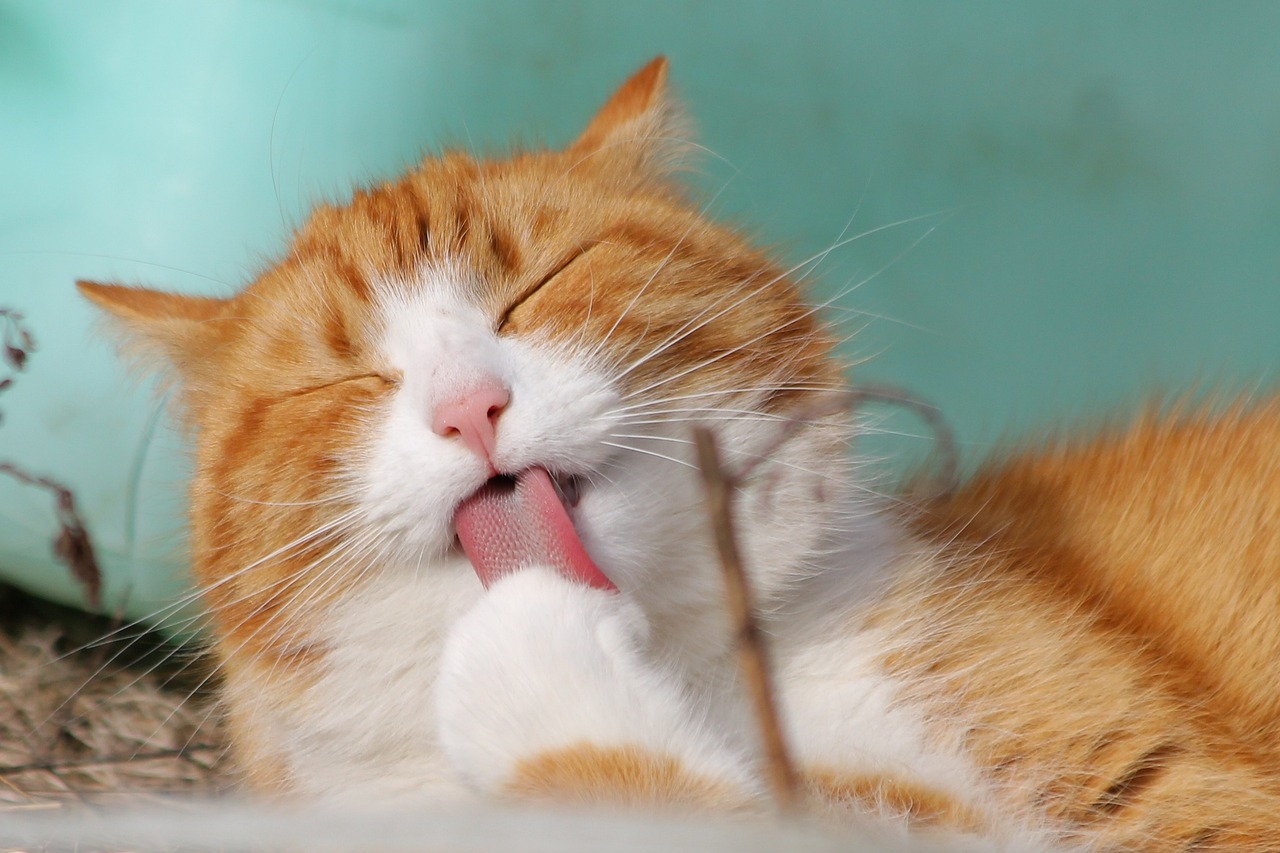
Storing and Serving Treats
When it comes to homemade pet treats, proper storage and serving methods are essential to ensure that your furry friends enjoy them safely and at their best quality. Just like we wouldn't want to munch on stale snacks, our pets deserve fresh and tasty treats that are both nutritious and enjoyable. So, how do we keep these goodies in prime condition? Let's dive into some practical tips!
First off, storage is crucial. Homemade treats can spoil quickly if not stored correctly. To keep them fresh, consider the following storage options:
- Room Temperature: If you plan to use the treats within a week, storing them in an airtight container at room temperature is perfectly fine. Make sure to keep them in a cool, dry place away from direct sunlight.
- Refrigeration: For treats that contain perishable ingredients, such as yogurt or meat, refrigerating them is a must. Use a sealed container to prevent moisture and odors from affecting the treats.
- Freezing: If you want to prepare a larger batch, freezing is an excellent option. Most homemade treats can be frozen for up to three months. Just make sure to wrap them tightly in plastic wrap or place them in a freezer-safe bag to prevent freezer burn.
Now, let’s talk about serving. Serving your pet treats can be a delightful experience for both you and your furry friend. Here are some tips to make treat time special:
- Portion Control: It’s important to serve treats in moderation. Too many treats can lead to weight gain and health issues. A good rule of thumb is to keep treats to less than 10% of your pet's daily caloric intake.
- Presentation: Make treat time fun! Use special bowls or treat dispensers to present the snacks. This not only makes it exciting for your pet but also helps in creating a routine around treat time.
- Timing: Consider when you give treats. Using them as rewards during training or as a special surprise after a walk can reinforce positive behavior and strengthen your bond.
Finally, always remember to check the freshness of the treats before serving. Just like we would sniff a snack to see if it’s still good, do the same for your pet’s treats. If they smell off or have changed in texture, it's better to err on the side of caution and discard them.
In summary, storing and serving homemade pet treats is all about keeping them fresh and making treat time enjoyable. With these tips, you can ensure that your beloved pets get the most out of their delicious snacks!
Here are some common questions pet owners have about storing and serving homemade treats:
- How long do homemade pet treats last? - Generally, homemade treats can last up to a week at room temperature, two weeks in the fridge, and up to three months in the freezer.
- Can I use leftover ingredients from my kitchen? - Yes, as long as they are safe for pets. Always check which ingredients are pet-friendly before use.
- What should I do if my pet refuses to eat the treats? - Pets can be picky! Try different flavors or textures, or consider adding a bit of their favorite food to entice them.
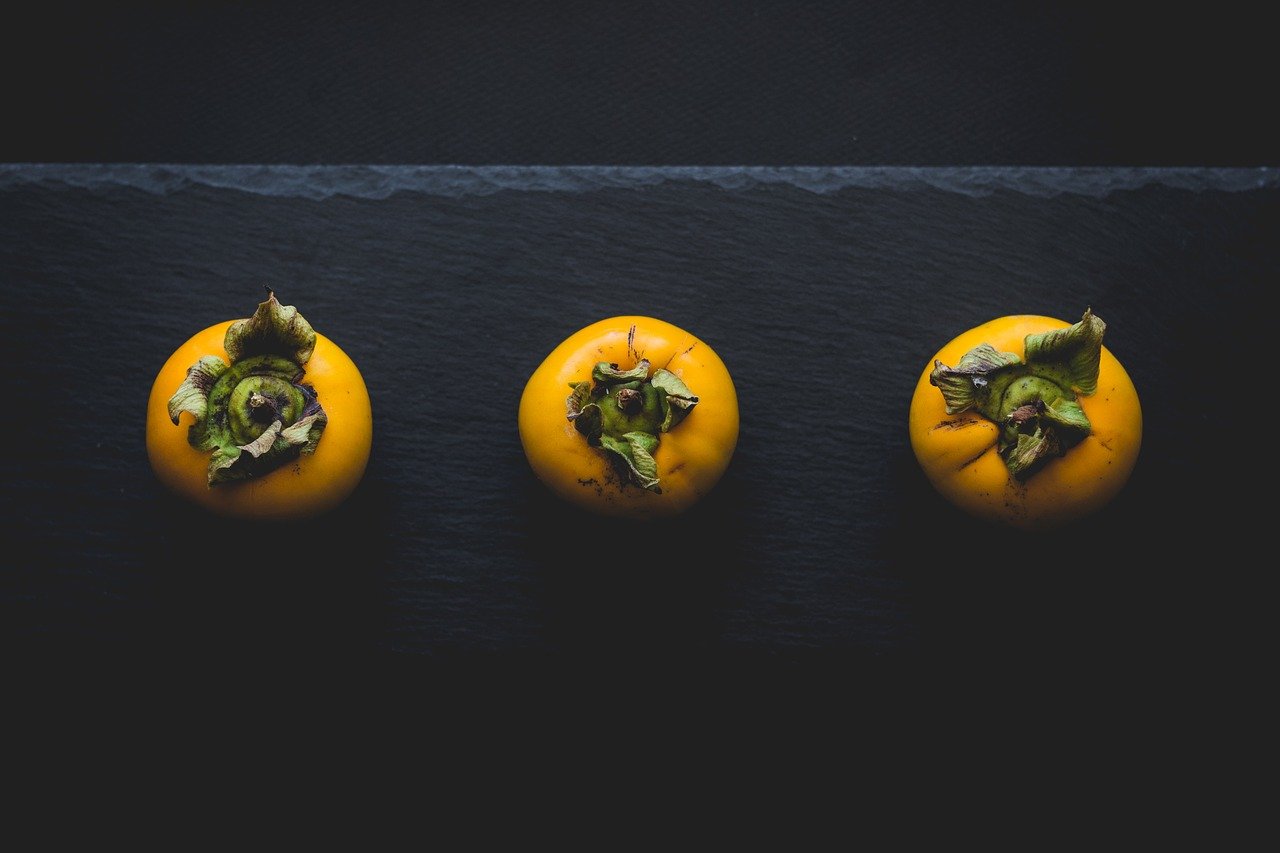
Monitoring Your Pet's Health
Once you've introduced new treats into your pet's diet, it's crucial to keep a close eye on their health. Just like humans, pets can have different reactions to new foods, and being vigilant can help you catch any potential issues early. You might be wondering, "What should I look for?" Well, there are several signs that can indicate how well your pet is adjusting to their new snacks.
First and foremost, keep an eye on their digestive health. After introducing a new treat, monitor for any signs of gastrointestinal distress, such as vomiting, diarrhea, or changes in appetite. If your pet seems to be having trouble, it might be time to reconsider the ingredients you're using. Remember, a sudden change in diet can sometimes lead to an upset stomach, so it's always wise to introduce new treats gradually.
Additionally, watch for any signs of allergies. Pets can be sensitive to certain ingredients just like humans. Look out for symptoms such as itching, redness, or swelling, particularly around the face or paws. If you notice any of these signs, it might be best to remove the new treat from their diet and consult your veterinarian.
Another important aspect to consider is your pet's overall energy levels. Are they more playful and lively, or do they seem lethargic? A sudden drop in energy could indicate that something isn't right. It's essential to ensure that the treats you're giving them are not only delicious but also provide the necessary nutrients to keep them active and healthy.
To help you better understand your pet's health after introducing new treats, here’s a quick reference table:
| Sign | Possible Issue | Action to Take |
|---|---|---|
| Vomiting | Gastrointestinal upset | Stop the new treats and consult a vet if it persists |
| Diarrhea | Possible food intolerance | Reassess the ingredients and introduce treats slowly |
| Itching or redness | Allergic reaction | Discontinue the treat and consult a vet |
| Lethargy | Health concerns | Monitor closely and seek veterinary advice if it continues |
Furthermore, keep track of your pet's weight. Treats can be calorie-dense, and it's easy to overdo it without realizing. If your pet starts gaining weight, you may need to adjust their overall food intake or reduce the number of treats given. A good rule of thumb is that treats should not make up more than 10% of your pet's daily caloric intake.
In conclusion, monitoring your pet's health after introducing new treats is essential for ensuring their well-being. By being observant and proactive, you can help your furry friend thrive on their new snacks. Remember, your pet relies on you to make the best choices for their health, so keep those eyes peeled!
- How long should I monitor my pet after introducing new treats? It's best to keep an eye on them for at least a week to observe any changes.
- What should I do if my pet shows signs of an allergic reaction? Discontinue the treat immediately and consult your veterinarian for advice.
- Can I give my pet human food as treats? Yes, but make sure to research which foods are safe and healthy for them.
- How can I tell if my pet is gaining weight? Regularly weigh your pet and observe their body condition; consult your vet for guidance if you're unsure.
Frequently Asked Questions
- What ingredients are safe for my pet?
When creating homemade treats for your pet, it’s essential to choose ingredients that are safe and nutritious. Common safe ingredients include fruits like apples and blueberries, vegetables such as carrots and sweet potatoes, and grains like oats and brown rice. Always do your research to ensure the ingredients are suitable for your specific pet.
- Are there any human foods I should avoid giving my pet?
Absolutely! Some human foods can be harmful to pets. Avoid ingredients like chocolate, grapes, onions, garlic, and avocados, as they can cause serious health issues. Always check with your veterinarian if you're unsure about a specific food item.
- How can I ensure my homemade treats are healthy?
To keep your homemade treats healthy, focus on using fresh, whole ingredients and avoid adding sugar, salt, or preservatives. Balance the recipe with a mix of proteins, healthy fats, and carbohydrates. It’s also a good idea to consult your vet for tailored advice based on your pet's dietary needs.
- Can I make treats for both dogs and cats?
Yes, but keep in mind that dogs and cats have different dietary needs and taste preferences. While some ingredients may be suitable for both, it’s important to tailor the recipes to each pet. For instance, dogs may enjoy peanut butter, while cats might prefer fish-based treats.
- How should I store homemade pet treats?
Store homemade treats in an airtight container to maintain freshness. Depending on the ingredients, you can keep them in the refrigerator for up to a week or freeze them for longer storage. Always label the containers with the date to keep track of freshness.
- What signs should I watch for after introducing new treats?
After introducing new treats, monitor your pet for any signs of digestive upset, such as vomiting, diarrhea, or changes in appetite. If you notice any adverse reactions, discontinue the treats and consult your veterinarian for advice.
- How often can I give my pet homemade treats?
Homemade treats should be given in moderation. They should complement your pet's regular diet rather than replace it. A good rule of thumb is to limit treats to no more than 10% of your pet's daily caloric intake to maintain a balanced diet.



